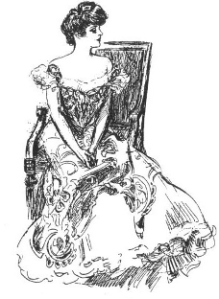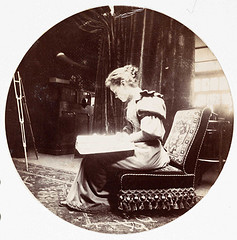During the nineteenth century, women’s language was restricted to the universal signifying order, which, while providing a basis for masculine subjecthood, was unable to fulfil women’s ontological requirements. Female use of masculine language merely reinforced the hegemonic order and led to further internalisation of its precepts. While the female hysteric was part of the masculine economy, she was powerless, confined to the domestic sphere wherein having no access to her own language she was precluded from the possibility of subjecthood. For women the only method of acquiring subjectivity was to utilise non-symbolic, bodily forms of communication. The psychosomatic nature of such expression challenged the epistemological basis of patriarchy founded upon Cartesian dualism and binary notions of gender. Confronted with such a contestation to its fundamental principles, patriarchal society posited the hysteric as Other which provided a justification for controlling female expression. Since only mutually intelligible utterances become comprehensible intercourse, the patriarchal refusal to accept transgressive female expression as a language resulted in the diagnosis of hysteria.
Such an ability to define permissible forms of linguistic communication became the central coercive device of the ‘closed masculine signifying economy’ [1], fundamental to which was the Kristevean mirror stage that ensured a subject/object division. By designating themselves as active individuals within such a binary, patriarchal subjects remained in control of masculine exchange. However, the frequent inability of the Victorian female character to recognise her reflection destabilised the subject/object binary established in the mirror stage. This thereby prevented the occurrence of the thetic phase by inhibiting delimitation of the fundamental components of masculine communication, self and Other. The hysteric therefore transgressed masculine society by existing beyond conceptions of subject and object, thereby invalidating the inherent power differential between those who are posited and those who posit.
The destabilising effect of such transgression was compounded by limitations in medical diagnostic ability which further undermined the Cartesian binary that was utilised by patriarchal society as a form of containment. Owing to the difficulty of observing and validating psychological phenomena, medical practioners accordingly preferenced easily quantifiable physical symptoms. Therefore, in spite of the attempt by the medical establishment to contain hysteria by promoting Cartesian dualism, the focus upon physical symptoms rather than emotional states created the potential for a further destabilisation of masculine control. This was due to the physician inadvertently promoting psychosomatic expression by encouraging women to disproportionately emphasise or invent physical components of psychological afflictions in order to receive treatment. The resulting proliferation of hysteria and irruption of the female chora therefore destabilised the masculine symbolic order.
Such contamination of symbolic masculine society with the urges of the ‘feminine’ body reintroduced the certainty of death to patriarchal society which existed in part to defend the masculine psyche from the realisation of the inevitability of mortality. This resulted from the exposure of women’s bodies to the damaging potential of the Kristevean death drive which the defensive construction of masculine symbolic language[2] attempted to resist. Accordingly, in Wuthering Heights Hindley Earnshaw’s wife Frances ‘began describing with hysterical emotion the effect it produced on her to see black…she felt so afraid of dying’[3]. Such hysterical transgression of masculine symbolic language and reintroduction of the death drive is also portrayed by Lucy Westenra who begins to resemble ‘a corpse after a prolonged illness’[4] and Catherine Earnshaw whose ‘cheeks, at once blanched and livid, assumed the aspect of death.’[5]
Fear of the chora and its transgressive potential is also apparent in masculine responses to menstrual blood which, being ‘a physiological marker of social disruption’[6], was a fundamental form of hysterical expression. Edgar Linton notes that Catherine ‘“has blood on her lips”’[7], a symbol of menstruation and an embodiment of Edgar’s concern of the Other’s uncontrollability. Therefore, rather than occurring via vocalisation which can be silenced, hysteria is communicated through the labial lips of the sexualised female body. Accordingly, as Baudrillard states, since ‘[o]nly the wounded body exists symbolically’[8], hysteria does not employ the schism of masculine language but communicates via the female wound in the hegemonic order ‘that would never heal’[9]. Similarly, pregnancy and childbirth, which also involve the release of transgressive female fluids, further destabilise the patriarchal order. Pregnant women in particular were perceived as threatening owing to their susceptibility to puerperal insanity which, by potentially leading to infanticide, subverted ideological notions of femininity and the nineteenth century family.
For the masculine order the female propensity towards transgressive hysterical physicality provided an excuse for denying women subjectivity. However, since ‘[h]ysteria is associated with women’s exclusion from the sphere of representation’[10] such prohibition became essentially self-fulfilling, promoting the very transgression that it endeavoured to prevent. This is depicted in Jane Eyre when Mrs Reed responds to Jane’s ‘wild, involuntary cry’[11] with an admonition that ‘“until you can speak pleasantly, remain silent.”’[12] As the novel’s plot reveals, restraint serves only to promote a more violent reaction. One such manifestation was the hysterical symptom of choking which was diagnosed by Jorden as Suffocation of the Mother since the capacity for expression was literally asphyxiated.
Female expression was also smothered by psychiatry through a masculine-conceived unconscious that disregarded a hysterical ontology which was unintelligible to the hegemonic order. Rather than attempting to engage with a potentially challenging alternative viewpoint, psychoanalysis instead imprisoned the female by re-inscribing hysteria according to masculine conceptions. As a result, nineteenth century representations of hysteria are ambiguous:
[o]n the one hand, representing woman as an inherently unstable female body authorizes ceaseless medical monitoring and control. But on the other hand, this representation of woman as always requiring control produces her as always already exceeding the control that medicine can excise.[13]
Therefore, by exceeded psychiatric containment hysteria challenged the very possibility of the medical epistemological project:
the language of hysteria forces its investigator to realise he cannot define or identify his subject, and thus it demarcates the limitations of the system of representation that it seeks to classify[14].
Accordingly, as patriarchy found hysterical language incomprehensible its very unintelligibility threatened the stability of the masculine order which attempted to contain it since hysteria emphasised hegemonic limitations.
Such destabilisation and mutual unintelligibility drew attention to semiotic female expression and symbolic masculine discourse as non-unified languages which can exist in isolation. As Julia Kristeva argues, hysterical and non-hysterical languages are both semiotic and symbolic:
[b]ecause the subject is always both semiotic and symbolic, no signifying system he produces can be either “exclusively semiotic or “exclusively” symbolic. And is instead necessarily marked by an indebtedness to both.[15]
Hysterical and masculine languages are thus only differentiated by their ratio of semiotic to symbolic content. Since hysteria is primarily expressed psychosomatically its focus upon the body marks it as predominantly semiotic, whereas medicalisation is symbolic because it externally represents physicality in the form of written and verbal symbols which render the body absent.
When either hysteria or medicalisation is viewed in isolation a disjunction occurs which causes loss of meaning. During psychosomatic communication the hysterical expression of semiotic drives and urges through the body results in a gap between the hysteric and the masculine receiver through which the semiotic drives of the hysteric cannot negotiate. It is in this space between subject and object, between signifier and signified that the meaning of hysteria becomes lost. Just as Virginia Woolf argued that ‘a room of her own’[16] was necessary for writing purely female literature, so too is segregation from masculine society necessary for the hysteric to create a purely female language. However, in doing so the female subject becomes trapped within a room of her own, wherein without a means of directing drives away from her body she is eventually consumed by her hysteria and unable to transmit meaning beyond her own physicality. Ultimately, the nineteenth-century novel portrays ‘women’s carceral condition as her fundamental and final truth’[17] since the critique that the hysteric poses of the masculine system becomes eliminated and re-inscribed when the woman is locked away, shut out of discourse behind Gilman’s suffocating and silencing yellow wallpaper where ‘nobody [can] climb through that pattern – it strangles so.’[18]
Instead, it is only by interrogating both masculine and feminine conceptions and ontological theories of hysteria that a meaningful appreciation of the condition can be attained. Neither language alone is able to adequately communicate female experience within the Victorian era therefore understanding can only be reached through examining their interaction. By doing so it is possible to synthesise a new language which is both male and female, symbolic and semiotic, and thus intelligible in a manner that neither hysteria or medicalisation can be in isolation.
[1] J. Butler, Gender Trouble: Feminism and the Subversion of Identity (London: Routledge, 1999), p.14
[2] J. Kristeva, ‘Revolution in Poetic Language’, in T. Moi, ed., The Kristeva Reader: Julia Kristeva (New York: Columbia University Press, 1986), p.103
[3] E. Brontë, Wuthering Heights (London: Penguin Books, 1995), I, chapter 6
[4] B. Stoker, Dracula (London: Penguin Books, 1994), chapter 10
[5] Brontë, Wuthering Heights, I, chapter 11
[6] S. Shuttleworth, Charlotte Brontë and Victorian Psychology (Cambridge: Cambridge University Press, 1996), p78
[7] Brontë, Wuthering Heights, I, chapter 11
[8] J. Baudrillard, Simulacra and Simulation – The Body in Theory: Histories of Cultural Materialism, trans. by S. Glaser (Ann Arbor: University of Michigan Press, 1994), p.114
[9] A. Carter, The Passion of New Eve (London: Virago Press, 2000), p.52
[10] M. Jacobus, Reading Women: Essays in Feminist Criticism (New York: Columbia University Press, 1986), p.29 in, P.M. Logan, Nerves and Narratives: A Cultural History of Hysteria in Nineteenth-Century British Prose (Califonia: University of California Press, 1997), p.9
[11] C. Brontë, Jane Eyre (London: Penguin Books, 1996), I, chapter 2
[12] ibid, I, chapter 1
[13] C. Gallagher and T. Laqueur, eds., The Making of the Modern Body: Sexuality and Society in the Nineteenth Century (London: University of California Press, 1987), p.147
[14] E. Bronfen, The Knotted Subject: Hysteria and its Discontents (New Jersey: Princeton University Press, 1998), p.102
[15] Kristeva, ‘Revolution in Poetic Language’, p.93
[16] V. Woolf, A Room of One’s Own (London: The Penguin Group, 1945), chapter 1
[17] Gallagher, The Making of the Modern Body, p.122
[18] C.P. Gilman, ‘The Yellow Wallpaper’ in, D.S. Davies, ed., Short Stories from the Nineteenth Century (Hertfordshire: Wordsworth, 2000), p.204



